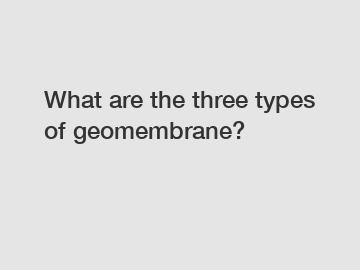What are the three types of geomembrane?
Geomembranes are flexible, impermeable liners used in a variety of construction projects to prevent water, liquid or gas from seeping into or out of a structure. They are manufactured from synthetic materials and come in three main types. Each type has specific qualities that make it suitable for different applications. In this blog post, we will explore the three types of geomembranes in detail.
1. HDPE Geomembranes:
High-density polyethylene (HDPE) geomembranes are one of the most commonly used types of geomembranes. They are made from a durable, high-density polyethylene resin that is resistant to chemicals, UV radiation, and punctures. HDPE geomembranes are known for their high tensile strength, flexibility, and resistance to environmental stress cracking.

HDPE geomembranes are ideal for applications where long-term performance and durability are essential. They are commonly used in landfill liners, mining operations, reservoirs, and wastewater treatment facilities. HDPE geomembranes are also used in containment systems for hazardous waste and industrial storage facilities.
One of the key advantages of HDPE geomembranes is their ease of installation. They can be prefabricated in large panels and welded together on-site to create a seamless barrier. This results in a cost-effective and efficient installation process. HDPE geomembranes also have a high puncture resistance, making them suitable for demanding applications where protection against sharp objects is required.
2. PVC Geomembranes:
Polyvinyl chloride (PVC) geomembranes are another commonly used type of geomembrane. PVC geomembranes are made from a synthetic plastic material that is resistant to chemicals, UV radiation, and punctures. They have a high flexibility and are easy to install, making them suitable for a wide range of applications.
PVC geomembranes are commonly used in applications where flexibility and ease of installation are important. They are used in pond liners, decorative ponds, and agricultural water storage tanks. PVC geomembranes are also used in roofing systems, tunnels, and reservoirs.
One of the key advantages of PVC geomembranes is their resistance to UV radiation. They have a high UV stabilization that makes them suitable for outdoor applications where exposure to sunlight is a concern. PVC geomembranes are also known for their high chemical resistance, making them ideal for applications where exposure to chemicals is a concern.
3. EPDM Geomembranes:
Ethylene Propylene Diene Monomer (EPDM) geomembranes are a third type of geomembrane that is used in a variety of applications. EPDM geomembranes are made from a synthetic rubber material that is highly flexible, durable, and resistant to UV radiation and punctures. They have a high tensile strength and are known for their long-lasting performance.
EPDM geomembranes are commonly used in applications where flexibility and durability are essential. They are used in pond liners, decorative ponds, and landscaping projects. EPDM geomembranes are also used in roofing systems, reservoirs, and agricultural water storage tanks.
One of the key advantages of EPDM geomembranes is their high flexibility. They can conform to irregular shapes and contours, making them ideal for applications where a seamless barrier is required. EPDM geomembranes are also known for their resistance to environmental stress cracking, making them suitable for demanding applications where exposure to harsh environments is a concern.
In conclusion, geomembranes are an essential component of many construction projects, providing a reliable and long-lasting solution for preventing water, liquid or gas from seeping into or out of a structure. The three types of geomembranes - HDPE, PVC, and EPDM - each offer unique qualities that make them suitable for different applications. Whether you are working on a landfill liner, pond liner, or roofing system, choosing the right geomembrane is essential for ensuring the success of your project.
Are you interested in learning more about ldpe smooth geomembrane supplier, geosynthetic clay liner supplier, concrete protective lining manufacturer? Contact us today to secure an expert consultation!

Comments
0